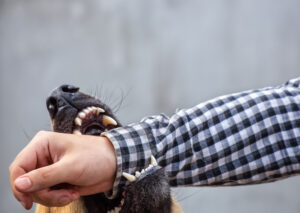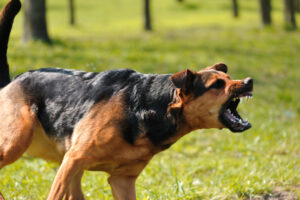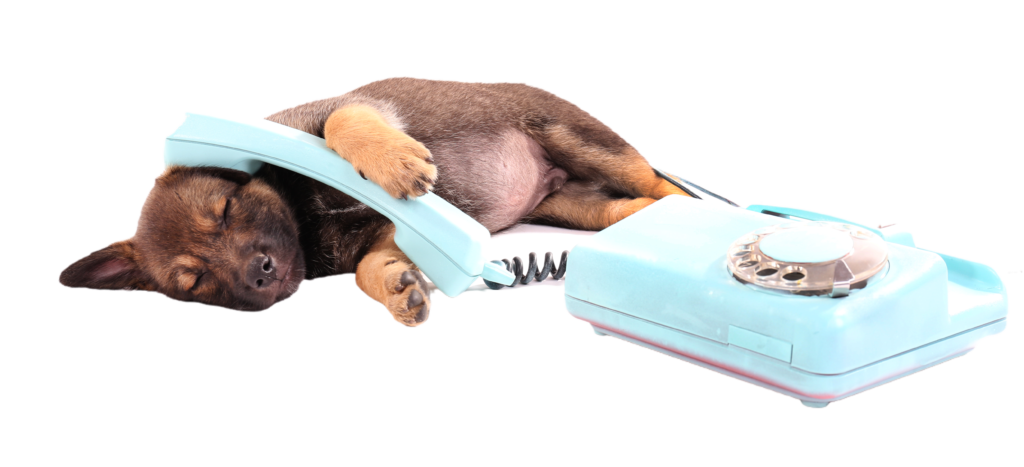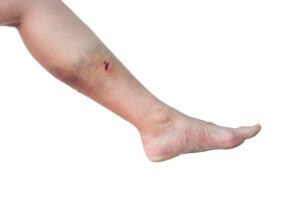Victim of an animal attack?
661-339-8806
When animals attack, we’ve got your back.
Key points to know about California’s dog bite law
- Strict Liability: California follows the principle of strict liability for dog bites. This means that a dog owner is liable for damages caused by their dog’s bite, regardless of whether the dog had previously shown any aggressive behavior or the owner’s knowledge of such behavior.

Civil Code section 3342(a) explains, “The owner of any dog is liable for the damages suffered by any person who is bitten by the dog while in a public place or lawfully in a private place, including the property of the owner of the dog, regardless of the former viciousness of the dog or the owner’s knowledge of such viciousness. A person is lawfully upon th e private property of such owner within the meaning of this section when he is on such property in the performance of any duty imposed upon him by the laws of this state or by the laws or postal regulations of the United States, or when he is on such property upon the invitation, express or implied, of the owner.”
e private property of such owner within the meaning of this section when he is on such property in the performance of any duty imposed upon him by the laws of this state or by the laws or postal regulations of the United States, or when he is on such property upon the invitation, express or implied, of the owner.”
- “Bite” Definition: California law also covers injuries caused by a dog’s actions other than biting. The law extends liability to injuries caused by a dog’s “vicious propensities.” This includes acts that are likely to cause harm or injuries to others, even if an actual bite did not occur.
- Public vs. Private Property: The dog bite law applies to both public places and private property, including the dog owner’s premises. However, in cases where the injured person was unlawfully on private property, such as trespassing, the dog owner’s liability may be reduced or eliminated.
- Statute of Limitations: In California, there is a time limit, known as the statute of limitations, within which a dog bite victim must file a lawsuit. Generally, the injured person has two years from the date of the incident to initiate legal action.
- Harm to Other Animals: The owner of an animal may be liable for harm the animal causes to other animals.
Civil Code section 3341 explains:
The owner, possessor, or harborer of any dog or other animal, that shall, on the premises of any person other than the owner, possessor, or harborer of such dog or other animal, kill, worry, or wound any bovine animal, swine, horse, mule, burro, sheep, angora goat, or cashmere goat, or poultry, shall be liable to the owner of the same for the damages and costs of suit, to be recovered in any court of competent jurisdiction:
1. In the prosecution of actions under the provisions of this chapter, it shall not be necessary for the plaintiff to show that the owner, possessor, or harborer of such dog or other animal, had knowledge of the fact that such dog or other animal would kill, wound or worry bovine animals, swine, horses, mules, burros, sheep, goats, or poultry.
2. Any person on finding any dog or dogs, or other animal, not on the premises of the owner or possessor of such dog or dogs, or other animal, worrying, wounding, or killing any bovine animals, swine, horses, mules, burros, sheep, angora or cashmere goats, may, at the time of finding such dog or dogs, or other animal, kill the same, and the owner or owners thereof shall sustain no action for damages against any person so killing such dog or dogs, or other animal.
Nothing in this section shall render an owner, possessor, or harborer of a dog liable for the accidental or unavoidable killing or injury of any bovine animal, swine, horse, mule, burro, sheep, angora goat, cashmere goat, or poultry which occurs in connection with or as a incident to the driving or herding the same from the premises of the owner, possessor, or harborer of the dog, whether such killing or injury occurs upon such premises or off of such premises.
Call us!
661-339-8806
How much is my case worth?
According to the Insurance Information Institute, the average insurance claim cost for a dog bite in 2022 was $64,555. However, each case is different, and we cannot guarantee or predict the outcome of your case. Consider the following when trying to determine the value of your case.
- Medical Expenses. You may recover for any medical expenses arising from the attack, including both past and future medical bills associated with ongoing care. This encompasses hospital expenses, plastic surgery costs, therapy bills, and any other necessary care resulting from the attack.
- Lost Wages. You may recover for both lost wages and for reduced earning capacity caused by the attack. If the attack prevents you from working or limits the type of work you can perform, all wages lost as a consequence should be compensated.
- Pet Expenses. If your own pet was attacked during the bite incident, you may be eligible for reimbursement of veterinary bills incurred for your pet’s treatment.
- Pain and Suffering, Considering the severe pain caused by dog bites, you should be compensated for the physical suffering endured due to the bite, which can persist for an extended period.
- Diminished Quality of Life. If the incident with the animal leads to disfigurement, permanent injury, or affects various aspects of your life, diminishing your quality of life and ability to enjoy activities, you may have the right to receive compensation.
- Emotional Distress. In case the attack causes emotional distress, compensation should be provided. This includes payment for anxiety-related issues or post-traumatic stress disorder (PTSD) if you experience trauma-related symptoms or relive the dog attack.
- Punitive Damages. If the owner of the aggressive animal was aware of its violent nature but still allowed it to engage with individuals, it may be possible to obtain punitive damages.
Special rules for animals that are repeat offenders and trained fighters
Special laws may apply to dogs that have previously bitten someone or who have been trained to fight. Civil Code section 3342.5 explains:
(a) The owner of any dog that has bitten a human being shall have the duty to take such reasonable steps as are necessary to remove any danger presented to other persons from bites by the animal.
(b) Whenever a dog has bitten a human being on at least two separate occasions, any person, the district attorney, or city attorney may bring an action against the owner of the animal to determine whether conditions of the treatment or confinement of the dog or other circumstances existing at the time of the bites have been changed so as to remove the danger to other persons presented by the animal. This action shall be brought

in the county where a bite occurred. The court, after hearing, may make any order it deems appropriate to prevent the recurrence of such an incident, including, but not limited to, the removal of the animal from the area or its destruction if necessary.
(c) Whenever a dog trained to fight, attack, or kill has bitten a human being, causing substantial physical injury, any person, including the district attorney, or city attorney may bring an action against the owner of the animal to determine whether conditions of the treatment or confinement of the dog or other circumstances existing at the time of the bites have been changed so as to remove the danger to other persons presented by the animal. This action shall be brought in the county where a bite occurred. The court, after hearing, may make any order it deems appropriate to prevent the recurrence of such an incident, including, but not limited to, the removal of the animal from the area or its destruction if necessary.
(d) Nothing in this section shall authorize the bringing of an action pursuant to subdivision (b) based on a bite or bites inflicted upon a trespasser, or by a dog used in military or police work if the bite or bites occurred while the dog was actually performing in that capacity.
(e) Nothing in this section shall be construed to prevent legislation in the field of dog control by any city, county, or city and county.
(f) Nothing in this section shall be construed to affect the liability of the owner of a dog under Section 3342 or any other provision of the law.
(g) A proceeding under this section is a limited civil case.
Call us!
661-339-8806
Local laws likely lead to larger liability
Local ordinances and codes may provide additional liability for the owners of animals. Before taking legal action in an animal attack case, it may be best to review all applicable laws. Consider the following examples.
Kern County Ordinance 7.08.150
A.It is unlawful for the owner of any dog to allow it to be on the private property of another person or on public property without the consent of the person owning, occupying or controlling the property. Animals on the property of another person with the consent of the person in charge of the property shall be under such restraint as is necessary to protect persons and other animals from injury and to protect the property from damage. In particular, dogs shall be restrained by a leash and under the immediate control of the handler or confined within an enclosed pen when on public property, unless the officer in charge of the property has consented to the owner exercising another form of restraint.
B.Any person who at any time finds any animal at large in violation of any of the provisions of this section may take up, confine and hold the animal, provided that such person shall within twenty-four (24) hours thereafter notify the director of the fact that he has the animal in his possession and shall surrender possession of the animal to the director upon demand when deemed by the director to be in the animal’s best interest and in accordance with the law. If the animal is taken up at a time when an animal shelter is not open for business, the person confining it shall within twenty-four (24) hours after the shelter reopens, notify the director.
Bakersfield Municipal Code 6.04.220
A. It is unlawful for any animal owner to cause, permit or allow a dog, whether or not the same is licensed and/or vaccinated, to stray, run, or in any other manner, to be at large in or upon any public highway, street, sidewalk, alley, lane, park or other public place, or upon the property of any person other than the animal owner, without the permission of the owner or occupant of such property; provided, however, that a dog is not at large within the meaning of this chapter if it is under the control of a competent person and restrained by a substantial chain or leash not exceeding six feet in length.
B. Any person finding at any time any dog at large contrary to the provisions of this chapter may take up and hold the same; provided, however, that such person so taking up such dog shall, within four hours after taking up such dog, or if such dog is taken up at a time when the city pound is not open for the transaction of business, within four hours after the pound is again open for business, notify the director of animal control of the fact that he has such dog in his possession and shall, upon demand, surrender possession of such dog to the director of animal control. It shall be the duty of the director of animal control to take custody of any such dog and impound the same subject to the provisions of this chapter.
Taft Municipal Code 8-2-12
(A) It shall be unlawful for the owner of any dog to allow it to be more than seventy five feet (75′) off his property unless it is restrained. In particular, dogs should be restrained by a leash not longer than six feet (6′) in length and in the immediate control of the handler.
(B) No owner shall fail to exercise proper care and control of his animals to prevent them from becoming a public nuisance as defined in section 8-2-2 of this chapter.
(C) Every female dog or cat in heat shall be confined in a building or secure enclosure in such a manner that such female dog or cat cannot come into contact with another animal except for planned breeding.
Call us!
661-339-8806

Court cases and special considerations
Assumption of Risk
A person who stops to help an injured dog while in public does not assume the risk of being harmed by the dog. (Davis v. Gaschler (1992) 11 Cal.App.4th 1392)
If a pet owner conceals known dangers from a veterinarian, he may not rely on the defense of assumption of risk. (Nelson v. Hall (1985) 165 Cal.App.3d 709)
A small child is not capable of assuming the risk of a dog bite. (Greene v. Watts (1962) 210 Cal.App.2d 103)
A person entering an enclosed yard after observing a dog with vicious behavior in the yard assumes the risk of being bitten. (Gomes v. Byrne (1959) 51 Cal.2d 418)
Bites
An animal biting a person’s clothing and causing the person to fall constitutes a “bite” within the meaning of the dog bite statute (Johnson v. McMahan (1998) 68 Cal.App.4th 173)
A person harmed by an animal may sue under the dog bite statute even if the person does not suffer a wound. (Johnson v. McMahan (1998) 68 Cal.App.4th 173; Frederickson v. Kepner (1947) 82 Cal.App.2d 905)
Even a muzzled animal can fall under the dog bite statute if it causes injury, notwithstanding the fact that the animal cannot “bite”. (Hicks v. Sullivan (1932) 122 Cal.App. 635)
Contributory Negligence
The defense of contributory negligence is not generally available against a small child, but the child could be a trespasser. (Bauman v. Beaujean (1966) 244 Cal.App.2d 384)
Damages
Damages are warranted for bites and scratches that cause nightmares, nervousness, and a condition of irritability. (Smythe v. Schacht (1949) 93 Cal.App.2d 315)
Immunity
Police officers are generally immune from liability for damages caused by dog a police dog when properly used during a lawful arrest. (Olvera v. City of Modesto (E.D.Cal.2014) 38 F.Supp.3d 1162)
Insurance
Automobile insurance generally covers damage caused by animals inside the insured vehicle. (Hartford Acc. & Indem. Co. v. Civil Service Emp. Ins. Co. (1973) 33 Cal.App.3d 26)
Vicarious Liability
Those who allow others to bring animals onto their property or into their vehicles may be vicariously liable for damage caused by the animals. (Westwater v. Southern Pac. Co. (1940) 38 Cal.App.2d 369)
Call us!
661-339-8806

What to do after an animal attack
- Gather the dog owner’s contact details, such as their homeowner’s insurance or renter’s insurance information.
- Obtain documentation confirming the attacking dog’s rabies vaccination status.
- Immediately seek medical care to treat the wound and record details of the incident.
- Obtain contact information from witnesses and anyone responsible for the dog at the time of the incident.
- Take photographs of the wound and the location where the incident occurred.
- Use your phone to take a video of the area of the attack so the animal’s owner cannot return and alter the scene, such as putting up “Beware of Dog” signs and then claiming you assumed the risk of the attack.
- Report the incident to the police and/or your local animal control agency.
- Call Pup Bite at 661-339-8806.
Call us!
661-339-8806

Who is Pup Bite?
We are a Licensed Document Assistant firm. We can help you with the paperwork necessary to file a court case against dog owners who fail to control their dogs. If you would like an attorney to assist with your case, we can introduce you to several attorneys or you can find your own.
1412 17th Street, Ste. 310P, Bakersfield, CA 93301